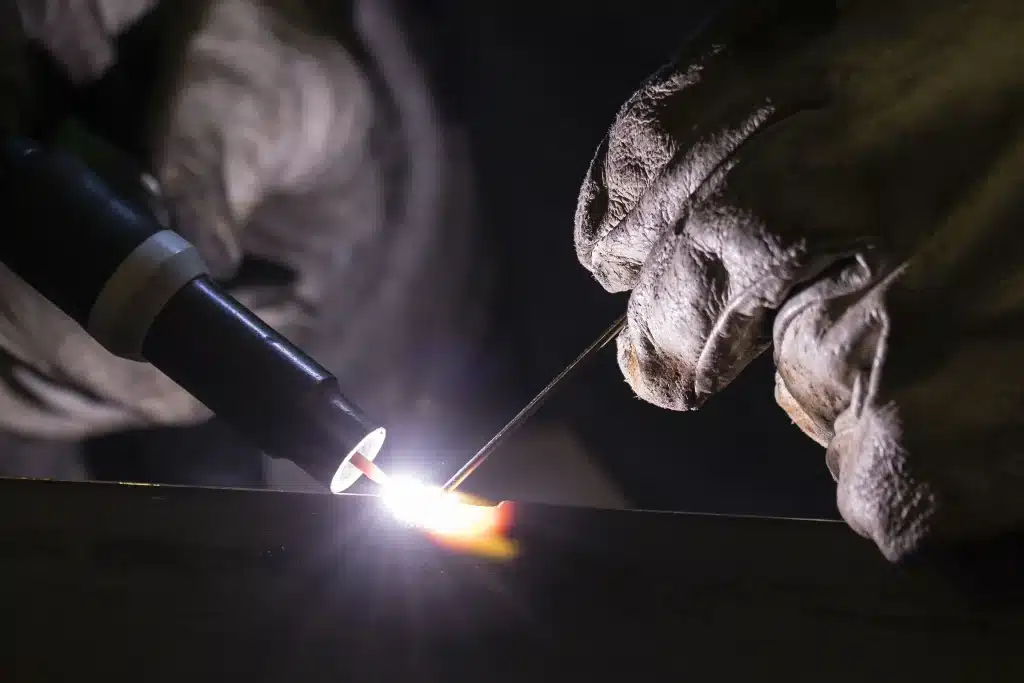TIG welding is a precision welding technique used to create high-quality, clean welds in a variety of metals. It’s a valuable skill for anyone interested in pursuing a career in welding, fabrication, or metalworking.
But becoming a skilled TIG welder takes more than just a steady hand and a willingness to learn. It requires a deep understanding of welding theory and materials science and a lot of practice.

In this article, we’ll take a closer look at how to become a TIG welder, from the essential tools and techniques to the mindset and dedication required to master this challenging craft.
Is TIG welding considered an in-demand job?
TIG welding, also known as gas tungsten arc welding or tungsten inert gas welding, is considered an in-demand job in many industries.
This is because TIG welding is a highly specialized welding technique that is used in a wide range of industries, including aerospace, automotive, manufacturing, and construction. TIG welder job demands are expected to grow by 3% from 2018 to 2028, and the average salary is decent.

One of the reasons TIG welding is in high demand over other welding processes is because of the quality of the welds it produces. TIG welding creates clean, precise welds that are free from spatter and require little to no post-weld cleaning. This is essential in industries where quality and precision are critical, such as in aerospace or medical equipment manufacturing.
Another reason TIG welding jobs are in demand is that it can be used to weld a wide range of materials, including aluminum, stainless steel, and titanium, which are commonly used in industries such as aerospace and automotive manufacturing. TIG welding is also commonly used to weld thin materials, making it a popular technique in the fabrication of custom metal parts and components.
In addition to the demand for TIG welders in various industries, such as the aircraft industry, the aging workforce in the welding industry has also created a shortage of skilled welders. This means that TIG welders, who require specialized training and experience, are in even higher demand.
What skills are needed to excel in a TIG welding career?
To excel in a TIG welding career, there are several necessary skills that are required:
Attention to Detail: TIG welding is a precision welding technique that requires a high level of attention to detail. A TIG welder must be detail-oriented and pay close attention to the weld pool, filler material, and weld bead to ensure that the weld is of high quality.
- Manual Dexterity: TIG welding requires steady hands and good manual dexterity. A TIG welder must be able to hold the torch and filler material steady while controlling the welding current and arc length and work with other hand tools.
- Technical Knowledge: TIG welding requires a solid understanding of welding theory, metallurgy, and materials science. A TIG welder must be able to read and interpret welding blueprints, understand welding procedures, and have a good knowledge of welding equipment.
- Patience: TIG welding is a slow and deliberate process that requires patience and concentration. A TIG welder must be able to take their time to ensure the weld is of the highest quality.
- Problem-Solving Skills: TIG welding can present unexpected challenges that require creative problem-solving skills. A TIG welder must be able to troubleshoot problems, such as gas leaks or welding defects, and find solutions to overcome them.
- Physical Fitness: TIG welding can be physically demanding, requiring long periods of standing, holding heavy welding equipment, and wearing protective gear. A TIG welder must be physically fit and able to work for extended periods without fatigue.
- Communication Skills: TIG welders often work as part of a team, and good communication skills are essential. A TIG welder must be able to communicate effectively with coworkers and supervisors, especially when working on complex projects.
Duties And Tasks Of TIG Welder
The duties and tasks of a TIG welder vary depending on the industry and job they are working on. However, some common duties and tasks of a TIG welder may include:
- Reading and interpreting blueprints and specifications: A TIG welder must be able to read and interpret blueprints, schematics, and welding specifications to understand the requirements for the welding project.
- Preparing materials: A TIG welder must prepare the materials that need to be welded, such as cleaning and deburring metal surfaces and cutting and fitting metal parts.
- Setting up welding equipment: A TIG welder must set up the welding equipment, including the TIG welding torch, welding power source, gas supply, and filler metal, and ensure that the equipment is in good working order.
- Welding: A TIG welder must use the TIG welding torch to create a high-quality weld that meets the project’s requirements. This involves controlling the welding current and arc length, feeding the filler metal, and manipulating the welding torch to create the desired weld bead, which is especially important in pipe welders or other applications.
- Inspecting welds: A TIG welder must inspect the completed welds to ensure that they meet the project’s requirements and are free from defects such as cracks, porosity, or incomplete penetration. Certified welding inspector must make sure everything is well built and strong.
- Maintaining equipment: A TIG welder must maintain and clean the welding equipment, such as changing out the tungsten electrode or replacing the welding gas, to ensure that it is in good working order.
- Troubleshooting: A TIG welder must be able to troubleshoot problems that may arise during the welding process, such as gas leaks, improper weld penetration, or welding defects.
How To Become A TIG Welder
Becoming a TIG welder involves a combination of education, training, and on-the-job experience. A high school diploma, bachelor’s degree, or equivalent is typically required to become a TIG welder. Courses in welding, metal fabrication, and math can provide a good foundation for a career in welding. Many vocational schools, community colleges, and trade schools offer welding training programs that provide hands-on training in welding techniques and safety practices. A welding program typically lasts between 6 months to 2 years, depending on the level of education.

Welding certification is not always required but can demonstrate a welder’s expertise and increase their job prospects. Certifications are offered by professional organizations, such as the American Welding Society (AWS), and require passing a welding test that demonstrates proficiency in a particular welding technique. Even though you can practice on your own, a certified welder will always have the advantage in job openings.
Many TIG welders learn their craft through on-the-job experience, often starting as an apprentice or assistant to a more experienced welder. This provides an opportunity to learn from experienced professionals, gain hands-on experience, and build a network of contacts in the industry. TIG welding is a constantly evolving field, and TIG welders must stay up-to-date with the latest welding techniques, materials, and equipment. This can be accomplished through continuing education courses, attending industry conferences, and networking with other professionals in the field.
TIG welding often requires working in a team, communicating with others, and problem-solving. Developing good communication, teamwork, and problem-solving skills can help a TIG welder to work more effectively with others and advance in their career.
Risks And Potential Hazards
TIG welding, like any welding process, involves certain risks and potential hazards. TIG welding produces fumes and gases that can be hazardous to health if inhaled.
These can include toxic metals, such as zinc, lead, and cadmium, as well as gases like argon, helium, and nitrogen. This job involves working with high temperatures, and welders can be at risk of burns from contact with the welding torch, hot metal, or molten metal.

Welding arc produces bright, intense light that can damage the eyes if the welder does not wear proper eye protection. Welders are also at risk of skin damage from exposure to ultraviolet radiation. TIG welding uses an electric arc to produce heat, and welders can be at risk of electric shock if they come into contact with the welding equipment or metal surfaces.
AC TIG welding produces loud noise levels that can be harmful to hearing if a welder does not wear proper hearing protection. Additionally, the job involves working in awkward positions or confined spaces, which can put a strain on the welder’s body and increase the risk of injury.
To minimize the risks and potential hazards of TIG welding, welders must take appropriate safety precautions and follow safety procedures. This includes wearing proper personal protective equipment, ensuring proper ventilation in the work area, following safe welding practices, and receiving proper training and certification. Employers also have a responsibility to provide a safe work environment and ensure that welders have the proper equipment, training, and support to work safely.
Is It Worth The Risk?
TIG welding can be a rewarding career that offers job security, good pay, and opportunities for advancement. However, it also comes with certain risks and hazards, as discussed earlier.
Some people may find the risks associated with TIG welding unacceptable or may not feel comfortable working with the high temperatures, hazardous materials, or electric currents involved in the process. Others may feel that the rewards of a TIG welding career outweigh the risks, and are willing to take steps to minimize the risks and ensure their safety.

Ultimately, it is up to the individual to weigh the potential risks and benefits of a TIG welding career and make a decision that is right for them. It is important to remember that with proper training, equipment, and safety precautions, many of the risks associated with TIG welding can be minimized or eliminated. Additionally, if an individual enjoys working with metal and has an interest in welding, pursuing a TIG welding career can be a fulfilling and rewarding path.
Conclusion
Becoming a TIG welder can be a fulfilling and rewarding career choice. With a combination of education, training, on-the-job experience, and ongoing professional development, individuals can build the skills and expertise needed to excel in this field.
However, it’s important to remember that TIG welder jobs, like any occupation, come with certain risks and hazards, and it is crucial to take proper safety precautions to ensure a safe work environment. Despite the challenges, a TIG welding career can offer job security, good pay, and opportunities for growth and advancement.
Resources
- https://bakersgas.com/blogs/weld-my-world/how-to-land-a-tig-welding-job
- https://www.indeed.com/career/tig-welder/career-advice
- https://www.ziprecruiter.com/Career/Tig-Welder/What-Is-How-to-Become
- https://www.zippia.com/tig-welder-jobs/how-to-become-a-tig-welder/
- https://www.nwtc.edu/academics-and-training/tig-welding




